Name: Field Mustard
Botanical Name: Brassica rapa
Form: wildflower
Parts Used: greens, seeds
Citation: Guenther, K. (2017, January 12) Field mustard as wildlife food [Web log post.] Retrieved: Readers supply the date, from http://wildfoods4wildlife.com
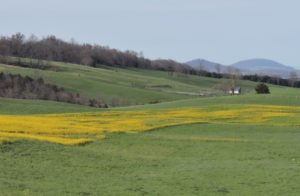
Getting Started
I decided to write a monograph about mustard not because it is a highly beneficial wildlife food, but because I have access to so much of it, and it is a green that is eaten by rabbits, to some extent. ( I am always on the lookout for rabbit greens.) Mustard–probably due to it’s hot flavors–is not in the top 150 favorite for seeds or greens and not offered as a main green food, even if you have a lot of it.
Since wild rabbits are a species that stresses out so easily with human handling in captivity, and since the center where I worked gets so many of bunnies (every year it is their number one admission), I like to collect as wide a variety of greens as possible so they have many different natural foods options.
Brassicaceae (Mustard Family)
Brassica (Mustard Genus)
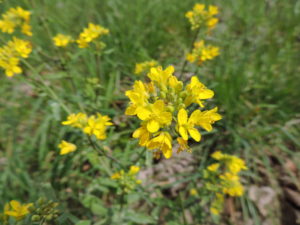
| Common name | Virginia Brassica Species | Origin | Rare Plant Status |
| Indian mustard | B. juncea | non-native | Not rare |
| Rape | B. napas | non-native | Not rare |
| Black mustard | B. nigra | non-native | Not rare |
| Field mustard | B. rapa | non-native | Not rare |

Key Features to Look For
In addition to the identification guide of your choice, here are a couple of features you should see on this plant:
- Bright yellow flowers with four petals, in many clusters.
- Flowers have 6 stamens, the 4 in the center are tall, the 2 on the sides are short (Elpel, 2013).
- The leaves are pale green gray and “clasp” the stem. Leaves are arrow shaped.
- Another flower stem grows out of the leaf axis where the leaf clasps the stem.
- Plant grows to about knee/thigh height.
- Seed pods are about 1” long (27 mm) or longer.
Risks
Many plant parts of many Brassica species have been toxic to horses, cattle, sheep, swine, goats, and poultry via the roots and seeds causing hemolytic anemia and Heinz bodies. Some species contain oxalates. Mustards can accumulate nitrates. Generally brassica species have had a lot and a variety of toxic compounds associated with them– as in cabbage, kale, broccoli, etc. but in recent decades researchers have apparently been able to reduce the quantity of toxic compounds in agriculturally grown species across the Brassica spp. through breeding programs, according to the Canadian Poisonous Plants Information System and also Cornell University. Wild species of mustards may still be more problematic. Do more research on your own to determine if any of these risks could be applicable to the animal you intend to feed, and for the parts of the plant you intend to use.
About This Species
Field mustard is a prolific spring non-native in my area, escapees from agriculture, so it is easy to find and easy to collect. Every year I see whole agricultural fields of it in bloom, beautiful against the blue mountains behind them. It is one of the brassica species that eastern cottontails might nibble on a little bit—but it is not a high on rabbit’s “favorites list”— so I just collect some as a item to be add variety to rabbit salads. A couple of birds eat mustard seeds, but I have never collected mustard seed in any great quantity.
Flower Description: Bright yellow flowers with four petals. Like all mustards, there are 6 stamens—2 are short and 4 are tall (Elpel, 2013). This is one of the best ID clues.
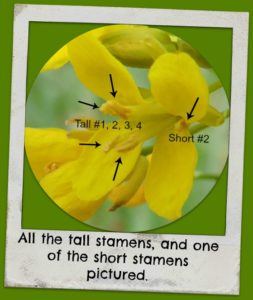
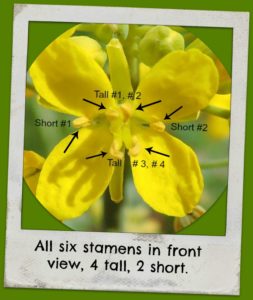
Leaf Description: The feature to look for here is that the long, gray-green, arrow shaped leaf clasps the stem. Leaves lower to the ground are more bulbous shaped with deep lobes.
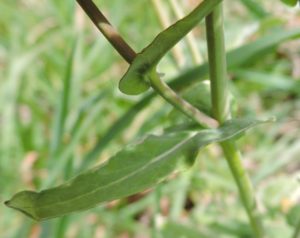
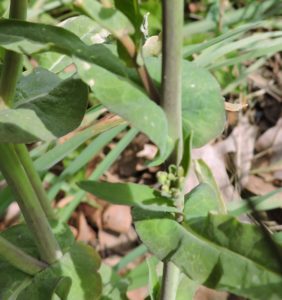
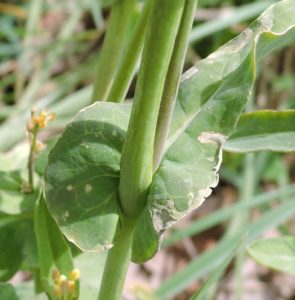
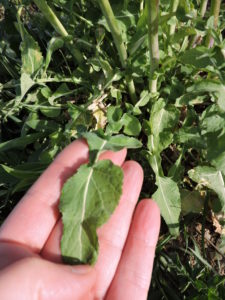
Seed Size: Seed matures inside vertical pods that form from what was the center of the flower. Each pod is about 1” long (27 mm) or longer and contains about 8 seeds lined up inside. The individual seed is very small—3/64th inch (1 mm), roundish and light brown. If looked at with a hand lens, the seed is textured and irregularly shaped and slightly flattened.
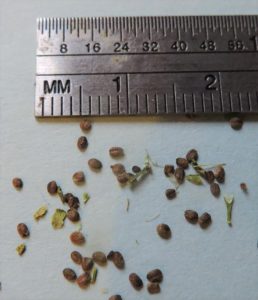
Harvesting
| Jan | Feb | Mar | Apr | May | Jun | Jul | Aug | Sep | Oct | Nov | Dec | ||||||||||||||
|---|---|---|---|---|---|---|---|---|---|---|---|---|---|---|---|---|---|---|---|---|---|---|---|---|---|
| winter | winter | late winter | early spring | spring | late spring | early summer | summer | late summer | early fall | fall | late fall | ||||||||||||||
| seed | x | x | x | x | |||||||||||||||||||||
| greens | x | x | x | x | |||||||||||||||||||||
Does this lend itself as a good enrichment item? Yes, as a birdseed item. Once the seed pods form, you can cut and dry the whole stalk, then install it for birds to glean the seeds out from the pods by themselves. Place upright stems in a dry, heavy based vase or container that will not tip over. Beware though, this is non-native plant seed you would be introducing into the enclosure and surrounding habitat.
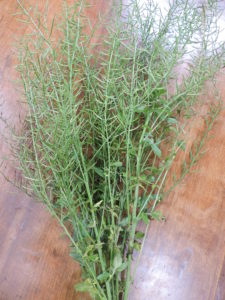
Harvesting Seed
Mustard is easy to see in the landscape when it is in flower, but once the flowers fade, the plant seems to disappear amidst other plants that grow up around it. The seed pods mature on the plant up to two months after the flower fades. I had never collected mustard seed prior to wanting to photograph it and write about it for this folio. I was pleasantly surprised how easy it was to clean the seed from the pods. I harvested about three plants in early July and dried the plants whole for about three weeks indoors. Cleaning the seed took less than fifteen minutes. I gathered up the brittle stalks and gathered them into a tight bundle in my hands, allowing the dry seed pods to break off and fall in the pan. After squeezing up and down the stalks to get all pods dislodged, I discarded the stalks. Then I crunched handfuls of dried pods in my fists to break them open. Then I sieved through two sizes of colander and called it done! Three plants generated about 1/8 cup of seed (30 ml). It would have been very easy to collect this plant and seed in higher quantities with little more effort.
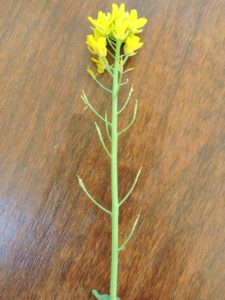
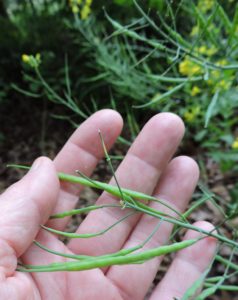
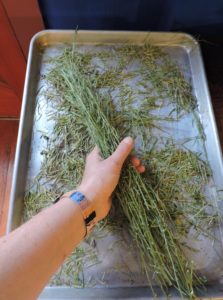
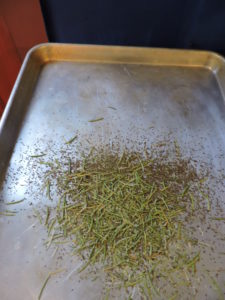
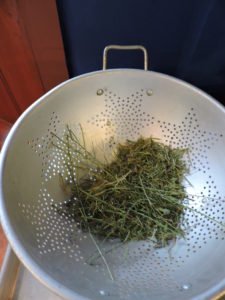
How to Store Prepared Seed:
Once cleaned and fully dried, choose a low humidity day—not a rainy day—to jar up your seed.
Glass or metal works best, because all plastics are somewhat porous to humidity. Canning jars and lids work well. Place seed in a tightly sealed, glass container and store in a dark, cool area for up to 1 year. Refrigeration and freezing work well. Label the airtight container with the seed name, date of harvest and which animals it should be used for.
If you intend to keep the seed longer than one year, jar up the seeds in two stages. First, jar the seeds up using a desiccant for up to 1 week. Then check the seed for dryness, and if dry enough, remove the desiccant and immediately repack the seed into an airtight container. Read more about drying seeds and using desiccants.
Keep stored seed in an airtight glass or metal container in a cool, dark place. Refrigeration and freezing works well, but allow container to warm to room temperature before opening. Discard any seed that ever appears moldy. http://www.wildfoods4wildlife.com
Harvesting Greens:
Mustard grows to about thigh high. I cut the whole plant at its base leave the flowers and leaves on and rough chop the stems into 8 inch sections to fit in my storage bags. I offer all above-ground parts and let the rabbits nibble which parts they choose.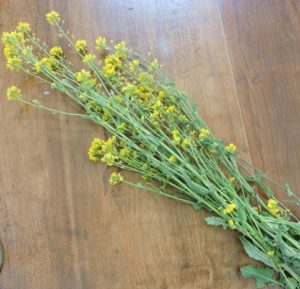
How to Store Prepared Greens:
If you choose to, use a commercial vegetable cleaner or a ¼ cup (60 ml) of vinegar added to wash water as a cleaner. Submerge the plant material and swish it around to remove all dirt from leaves and roots. Rinse in clean water. Always wash greens; you never know what might be on them…like animal feces or urine. Place in a colander or salad spinner to drain, then layout a towel and spread the greens on the towel and roll up the towel. Unroll and transfer the damp greens to storage.
For storage, there are a couple of different possible container methods. If the greens will be used quickly within days, place the spun-and-towel-rolled damp greens to a 1 gallon zip-lock baggie with 12-15 holes cut in it to provide air and keep the greens from molding (or reuse commercial grape bags with holes). Label the bag with the plant name and which animals it should be used for. Keep container in the vegetable drawer of the refrigerator.
For storage longer than one week, use a rigid, lidded, airtight container. After washing and salad spinning the greens, place a paper towel in the bottom, then loosely fill with greens, but do not pack them in. Then lay a paper towel on top and put on lid. Keep container in the vegetable drawer of the refrigerator. Do not use if greens become moldy, slimy or dried out.
Many greens are very sensitive to exposure to ethylene gas, though greens themselves are low emitters of the gas. You may get longer quality by adding with a product that reduces free ethylene gas in the refrigerator. Greens are good until they become dry and crispy, fade in color, or become slimy or moldy. More info on storing greens.
Rare Species in Virginia
No rare species in Virginia.
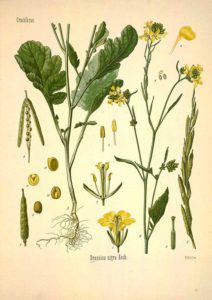
Feed Mustard to:
mustard | (Brassica spp.) | greens |
|---|---|---|
 Caution: Many plant parts of many Brassicas can be toxic to livestock causing hemolytic anemia and Heinz bodies. Brassicas also can have oxalates and accumulate nitrates in greens.(Canadian Biodiversity Information Facility, 2013) | ||
Cottontail, Eastern | Sylvilagus floridanus |
|
mustard | (Brassica spp.) | seeds |
 Caution: Many plant parts of many Brassicas can be toxic to livestock causing hemolytic anemia and Heinz bodies. Brassicas also can have oxalates and accumulate nitrates in greens.(Canadian Biodiversity Information Facility, 2013) | ||
Dove, Mourning | Zenaida macroura |
|
Sparrow, American Tree | Spizella arborea |
|
Book References:
Elpel, T.J. (2013) Botany in a Day (APG). Pony, Montana: Hops Press, LLC.
Martin, A.C., Zim, H.S., Nelson, A.L. (1951). American Wildlife and Plants: A Guide to Wildlife Food Habits. New York: Dover Publications.
Scott, M. (2013). Songbird Diet Index. National Wildlife Rehabilitators Association, St. Cloud, MN.
On-line References:
Canadian Poison Plants Information System. (n.d.) Retrieved on 8/6/17 from the Canadian Biodiversity Information Facility at http://www.cbif.gc.ca/eng/species-bank/canadian-poisonous-plants-information-system/canadian-poisonous-plants-information-system/?id=1370403266275
USDA, NRCS. 2015. The PLANTS Database (http://plants.usda.gov, 11 April 2016). National Plant Data Team, Greensboro, NC 27401-4901 USA.
Virginia Botanical Associates. (Accessed April 2016). Digital Atlas of the Virginia Flora (http://www.vaplantatlas.org). c/o Virginia Botanical Associates, Blacksburg.
